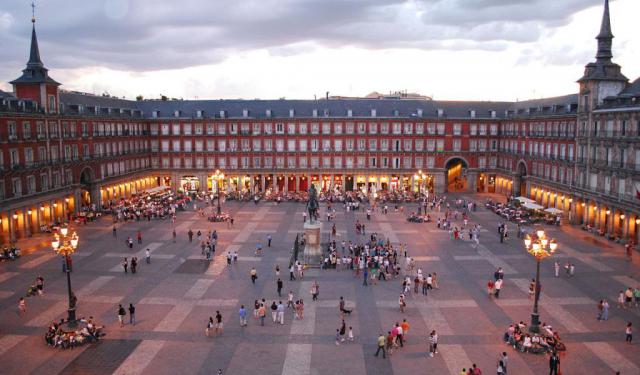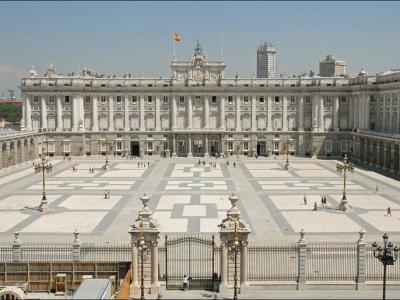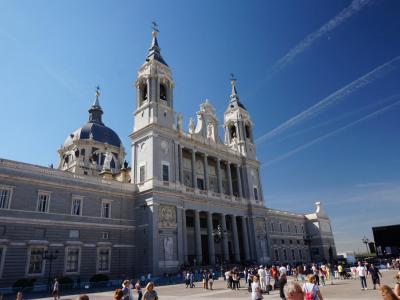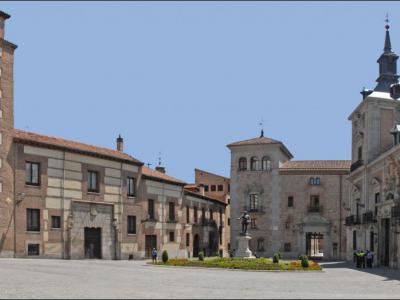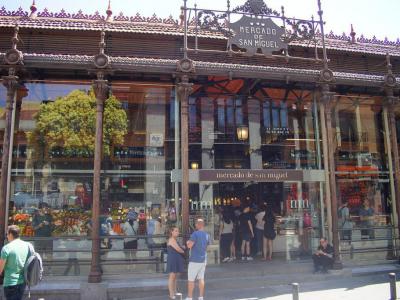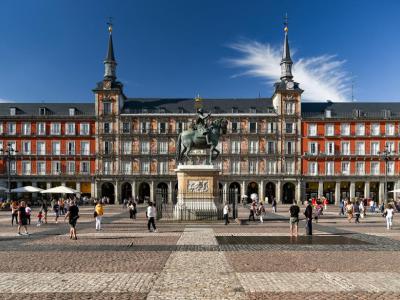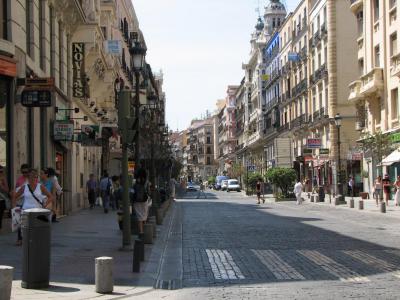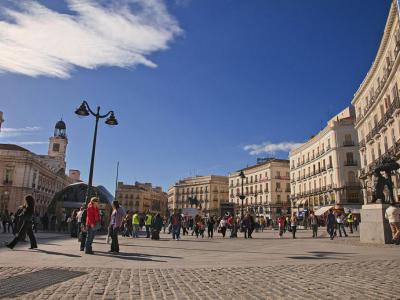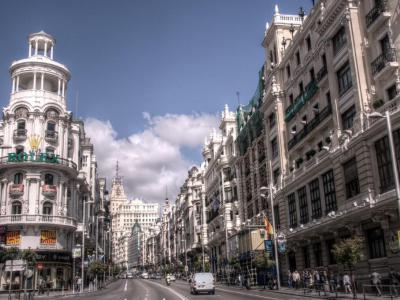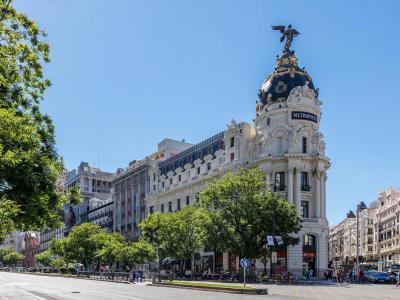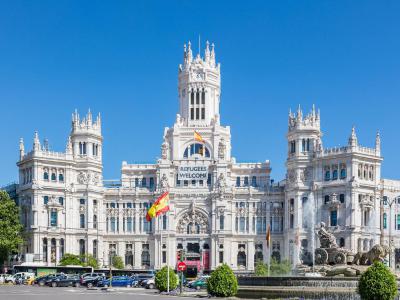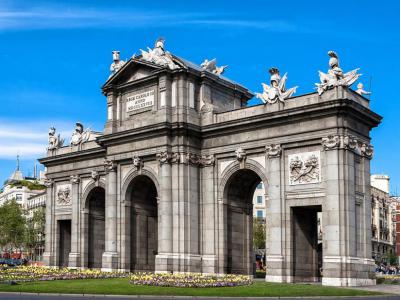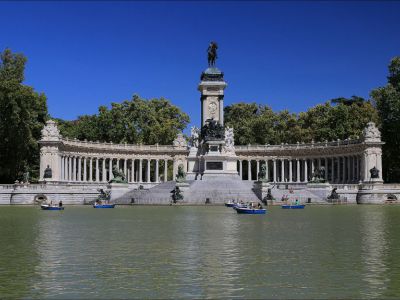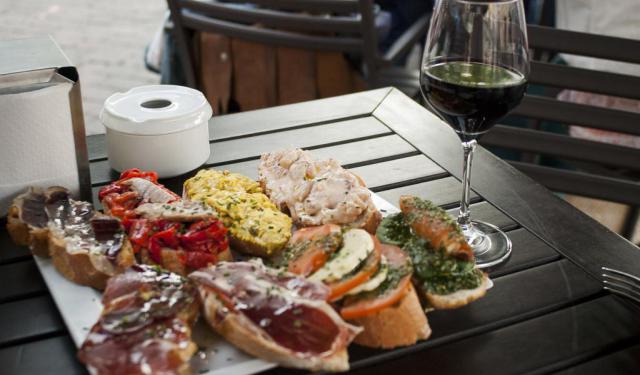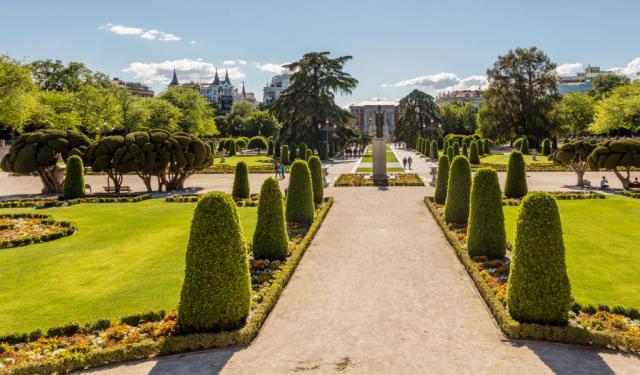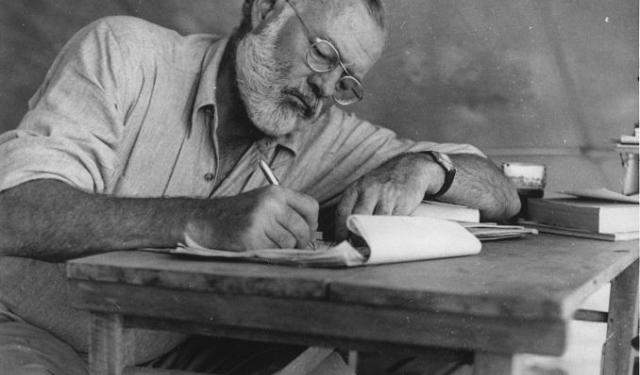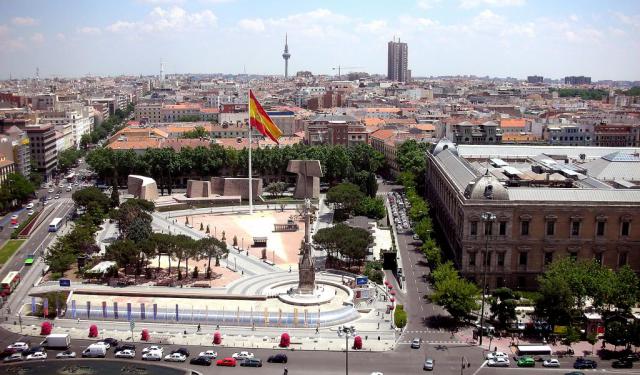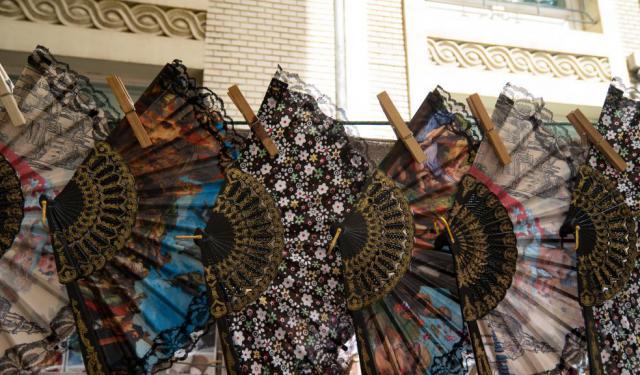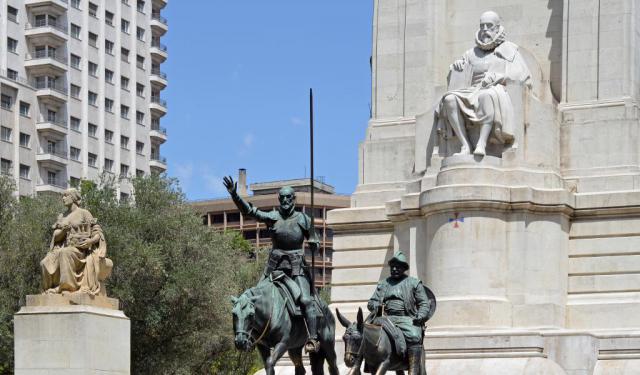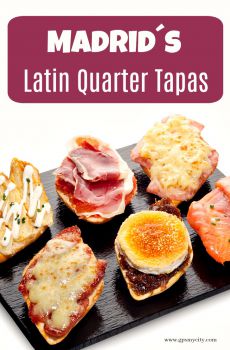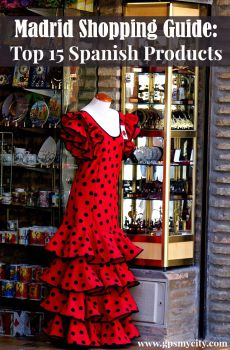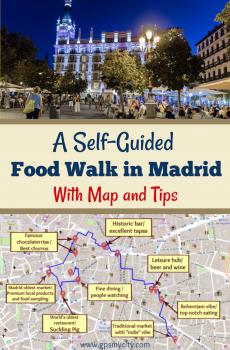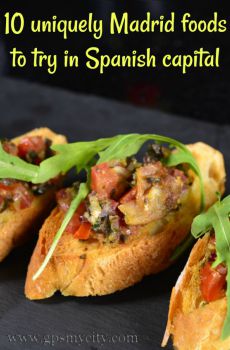Audio Guide: Madrid Introduction Walking Tour (Self Guided), Madrid
Welcome… to Madrid! A city where regal boulevards unfold like film reels, where iron balconies whisper old gossip, and where history has a flair for the dramatic. The Spanish capital is less a city, more a vast museum with a pulse, cradling centuries of European art, powdered baroque façades, and monuments that speak in old tongues if you listen close enough.
Madrid’s story begins long before streetlamps and tapas. Prehistoric humans once roamed this soil. But the first traceable echo of a real settlement comes from the Muslim era, sometime in the 9th century. A fortification-Mayrit-watching the Manzanares River. By 1085, the Christians had claimed it, folding it into the kingdom of Castile like a page in a manuscript.
Fast forward to the 17th century, Madrid explodes-not with bombs, but with brilliance. Cervantes scribbles. Velázquez paints. Quevedo sharpens his wit. Lope de Vega stages brilliant drama before supper. A city blazing with minds too bright to hold still.
The 1930s brought another period of great vitality-but then came the Civil War. Madrid, fiercely Republican and anti-fascist: bombed, broken, bleeding-yet refusing to fall. November 1936 saw street-to-street resistance, a city as battleground and beacon.
From ashes to acceleration: between 1959 and 1973, the economic boom transforms the city. Glass and steel claw toward the sky. A new middle class struts into being, slick with optimism. Franco dies, the constitution breathes, and in 1978, Madrid is officially, finally, constitutionally crowned the capital of a democratic Spain.
Yet-despite the metro lines, the fiber-optics, the touchscreen timetables-it remains ancient just below. Glass towers wink at medieval alleys. Trendy cafés share walls with haunted taverns. The city doesn’t just preserve its history. It wears it like perfume.
So… ready to walk the walk? This self-guided tour doesn’t just take you to the top landmarks. It invites you to slip between centuries, to eavesdrop on time itself, and to find out why Madrid isn’t just a place worth visiting-it’s a place worth feeling.
Let’s begin.
Madrid’s story begins long before streetlamps and tapas. Prehistoric humans once roamed this soil. But the first traceable echo of a real settlement comes from the Muslim era, sometime in the 9th century. A fortification-Mayrit-watching the Manzanares River. By 1085, the Christians had claimed it, folding it into the kingdom of Castile like a page in a manuscript.
Fast forward to the 17th century, Madrid explodes-not with bombs, but with brilliance. Cervantes scribbles. Velázquez paints. Quevedo sharpens his wit. Lope de Vega stages brilliant drama before supper. A city blazing with minds too bright to hold still.
The 1930s brought another period of great vitality-but then came the Civil War. Madrid, fiercely Republican and anti-fascist: bombed, broken, bleeding-yet refusing to fall. November 1936 saw street-to-street resistance, a city as battleground and beacon.
From ashes to acceleration: between 1959 and 1973, the economic boom transforms the city. Glass and steel claw toward the sky. A new middle class struts into being, slick with optimism. Franco dies, the constitution breathes, and in 1978, Madrid is officially, finally, constitutionally crowned the capital of a democratic Spain.
Yet-despite the metro lines, the fiber-optics, the touchscreen timetables-it remains ancient just below. Glass towers wink at medieval alleys. Trendy cafés share walls with haunted taverns. The city doesn’t just preserve its history. It wears it like perfume.
So… ready to walk the walk? This self-guided tour doesn’t just take you to the top landmarks. It invites you to slip between centuries, to eavesdrop on time itself, and to find out why Madrid isn’t just a place worth visiting-it’s a place worth feeling.
Let’s begin.
How it works: Download the app "GPSmyCity: Walks in 1K+ Cities" from Apple App Store or Google Play Store to your mobile phone or tablet. The app turns your mobile device into a personal tour guide and its built-in GPS navigation functions guide you from one tour stop to next. The app works offline, so no data plan is needed when traveling abroad.
Madrid Introduction Walking Tour Map
Guide Name: Madrid Introduction Walking Tour
Guide Location: Spain » Madrid (See other walking tours in Madrid)
Guide Type: Self-guided Walking Tour (Sightseeing)
# of Attractions: 12
Tour Duration: 2 Hour(s)
Travel Distance: 3.8 Km or 2.4 Miles
Author: emma
Sight(s) Featured in This Guide:
Guide Location: Spain » Madrid (See other walking tours in Madrid)
Guide Type: Self-guided Walking Tour (Sightseeing)
# of Attractions: 12
Tour Duration: 2 Hour(s)
Travel Distance: 3.8 Km or 2.4 Miles
Author: emma
Sight(s) Featured in This Guide:
- Palacio Real (Royal Palace of Madrid)
- Catedral de la Almudena (Almudena Cathedral)
- Plaza de la Villa (Town Hall Square)
- Mercado de San Miguel (Saint Michael's Market)
- Plaza Mayor (Town Square)
- Calle Mayor (High Street)
- Puerta del Sol (Gate of the Sun)
- Gran Via (Great Way)
- Edificio Metropolis (Metropolis Building)
- Palacio de Cibeles (Cibeles Palace)
- Puerta de Alcala (Alcala Gate)
- Parque del Retiro (Retiro Park)
1) Palacio Real (Royal Palace of Madrid) (must see)
Touring this palace feels like wandering through one of the world’s most exquisite art galleries. You’ll discover a stunning array of masterpieces, from paintings and frescoes to porcelain, ornate furniture, silverware, and other historically significant treasures. Among the standout features is the only complete set of Stradivarius string quintet instruments-a true musical marvel.
The palace we see today was commissioned by Felipe V after the 9th-century wooden Moorish Alcázar fortress was lost to a devastating fire in 1734. Drawing inspiration from the lavish splendor of Versailles, where Felipe had been raised, the Bourbon king envisioned a magnificent French-Italian-style structure built from stone and granite. Although Felipe didn’t live to see its completion, the palace was finally ready for use during the reign of Carlos III in 1764. What the exterior lacks in flamboyance, the interior more than makes up for: lavish marble floors, celestial frescoes, and golden furnishings tell a story of wealth and power, standing in stark contrast to Spain’s declining status at the time.
Don’t miss the awe-inspiring Throne Room, with its ceiling by Tiepolo illustrating the Majesty of Spain, or the Gasparini Room, whose silver silk-embroidered walls and intricate marble mosaic floor offer a mesmerizing display. The Porcelain Room, with its dazzling gold, green, and white porcelain decor, is another showstopper.
Beyond the main palace, you can explore the renowned Royal Armory, home to one of the world’s finest collections of historic weapons and armor. There is also an 18th-century pharmacy resembling a laboratory and the Painting Gallery, with works by Caravaggio, Velázquez, and Goya.
Tips:
If you’re planning a visit, set aside a few hours to take it all in. To beat the crowds and save time, consider booking your tickets online in advance.
The palace we see today was commissioned by Felipe V after the 9th-century wooden Moorish Alcázar fortress was lost to a devastating fire in 1734. Drawing inspiration from the lavish splendor of Versailles, where Felipe had been raised, the Bourbon king envisioned a magnificent French-Italian-style structure built from stone and granite. Although Felipe didn’t live to see its completion, the palace was finally ready for use during the reign of Carlos III in 1764. What the exterior lacks in flamboyance, the interior more than makes up for: lavish marble floors, celestial frescoes, and golden furnishings tell a story of wealth and power, standing in stark contrast to Spain’s declining status at the time.
Don’t miss the awe-inspiring Throne Room, with its ceiling by Tiepolo illustrating the Majesty of Spain, or the Gasparini Room, whose silver silk-embroidered walls and intricate marble mosaic floor offer a mesmerizing display. The Porcelain Room, with its dazzling gold, green, and white porcelain decor, is another showstopper.
Beyond the main palace, you can explore the renowned Royal Armory, home to one of the world’s finest collections of historic weapons and armor. There is also an 18th-century pharmacy resembling a laboratory and the Painting Gallery, with works by Caravaggio, Velázquez, and Goya.
Tips:
If you’re planning a visit, set aside a few hours to take it all in. To beat the crowds and save time, consider booking your tickets online in advance.
2) Catedral de la Almudena (Almudena Cathedral)
Almudena Cathedral, a project centuries in the making, finally opened in 1993 after a history marked by financial difficulties and Civil War bombing. Its neoclassical exterior, planned in the 1940s, contrasts beautifully with the neo-Gothic interior. Inside, sunlight streams through rose windows, casting a soft glow over the Latin-cross layout. A majestic dome crowns the transept, while vibrant ceiling designs and a 16th-century altarpiece in the Almudena chapel are particularly awe-inspiring.
Near the main entrance, a small museum showcases some of the cathedral’s treasures, but the true highlight is climbing to the dome. From this vantage point, you’ll enjoy sweeping views of Madrid and a close-up look at the towering statues of saints that stand watch over the city. The immense crypt, accessible from Calle Mayor, is another must-see. Its neo-Romanesque capitals, colorful stained-glass windows, and the figure of the Virgin of the Almudena create a tranquil, reverent atmosphere.
Tip: After exploring the crypt, cross the street to find remnants of ancient walls-built by the Moors in the 9th century and the Christians in the 12th-now part of Emir Mohammed I park, which occasionally hosts concerts.
Near the main entrance, a small museum showcases some of the cathedral’s treasures, but the true highlight is climbing to the dome. From this vantage point, you’ll enjoy sweeping views of Madrid and a close-up look at the towering statues of saints that stand watch over the city. The immense crypt, accessible from Calle Mayor, is another must-see. Its neo-Romanesque capitals, colorful stained-glass windows, and the figure of the Virgin of the Almudena create a tranquil, reverent atmosphere.
Tip: After exploring the crypt, cross the street to find remnants of ancient walls-built by the Moors in the 9th century and the Christians in the 12th-now part of Emir Mohammed I park, which occasionally hosts concerts.
3) Plaza de la Villa (Town Hall Square)
For a peaceful retreat in the heart of Madrid, look no further than the Town Hall Square. Just steps from Calle Mayor and close to the Town Square (“Plaza Mayor”), this medieval gem is among the city’s best-preserved historical landmarks. Surrounded by striking buildings that tell the story of Spanish architecture over three centuries, it offers a window into the past.
Dominating the square is the old Town Hall, or “Casa de la Villa,” a masterpiece of Habsburg Madrid completed in 1696. Noted for its beautiful stained glass windows and frescoes by Antonio Palomino, this building embodies elegance. Across the archway is the 16th-century Cisneros House, a prime example of early Spanish Renaissance style, boasting an intricate Plateresque facade and an exceptional collection of fine tapestries.
Near the Town Hall, the Lujanes House and Tower are reputedly the oldest structures in the city. Dating back to the early 15th century, the tower has an intriguing legend. Following the Battle of Pavia in 1525, King Charles I reportedly imprisoned France’s King Francis I in this very place. The French monarch, refusing to bow to his captor, was forced to use a lowered entrance, thus “bowing” each time he entered or exited-an enduring tale that adds to the tower’s mystique.
At the square’s center stands a tribute to Admiral Álvaro de Bazán, the Spanish naval hero who never lost a battle during his 50-year career. The statue, unveiled in 1891, marks the 300th anniversary of his passing.
Dominating the square is the old Town Hall, or “Casa de la Villa,” a masterpiece of Habsburg Madrid completed in 1696. Noted for its beautiful stained glass windows and frescoes by Antonio Palomino, this building embodies elegance. Across the archway is the 16th-century Cisneros House, a prime example of early Spanish Renaissance style, boasting an intricate Plateresque facade and an exceptional collection of fine tapestries.
Near the Town Hall, the Lujanes House and Tower are reputedly the oldest structures in the city. Dating back to the early 15th century, the tower has an intriguing legend. Following the Battle of Pavia in 1525, King Charles I reportedly imprisoned France’s King Francis I in this very place. The French monarch, refusing to bow to his captor, was forced to use a lowered entrance, thus “bowing” each time he entered or exited-an enduring tale that adds to the tower’s mystique.
At the square’s center stands a tribute to Admiral Álvaro de Bazán, the Spanish naval hero who never lost a battle during his 50-year career. The statue, unveiled in 1891, marks the 300th anniversary of his passing.
4) Mercado de San Miguel (Saint Michael's Market) (must see)
Saint Michael’s Market may not be Madrid’s largest, but it holds a unique place in the city’s history as the last surviving iron marketplace. Originally built in 1915, this striking single-level structure, encased in glass, served as a traditional neighborhood market for nearly a century. After an ambitious transformation in 2009, it emerged as a celebrated gastronomic destination, inspiring the rise of gourmet markets not just in Madrid, but across Spain.
Situated on the site of a former church-demolished in 1810 during the rule of Joseph Bonaparte-San Miguel now houses an impressive variety of food stalls. Here, you can savor freshly prepared dishes representing Spain’s diverse culinary traditions. If you’re unsure what to try, don’t hesitate to ask for a sample and find your new favorite flavor.
Beyond its tempting food offerings, the market features a wine bar, a vermouth bar, and even a flamenco venue. Live music performances add to the lively ambiance, making it much more than just a place to eat.
Tip: Before stepping inside, glance up at the fallen angel statue-“Accidente Aereo”-above the main entrance. While not as famous as the one in Retiro Park, it’s no less spectacular. And when nature calls, keep a receipt from one of your purchases handy; it might save you a restroom fee.
Situated on the site of a former church-demolished in 1810 during the rule of Joseph Bonaparte-San Miguel now houses an impressive variety of food stalls. Here, you can savor freshly prepared dishes representing Spain’s diverse culinary traditions. If you’re unsure what to try, don’t hesitate to ask for a sample and find your new favorite flavor.
Beyond its tempting food offerings, the market features a wine bar, a vermouth bar, and even a flamenco venue. Live music performances add to the lively ambiance, making it much more than just a place to eat.
Tip: Before stepping inside, glance up at the fallen angel statue-“Accidente Aereo”-above the main entrance. While not as famous as the one in Retiro Park, it’s no less spectacular. And when nature calls, keep a receipt from one of your purchases handy; it might save you a restroom fee.
5) Plaza Mayor (Town Square) (must see)
Madrid’s grand and dramatic Town Square was initially dreamed up by King Felipe II, who, in the late 16th century, envisioned a more prestigious focal point for his new capital. The oldest building here, known as the Bakery House, dates back to 1590, though extensive rebuilding occurred after devastating fires in the 17th and 18th centuries. Interestingly, its eye-catching frescoes are relatively new, added as recently as 1992. Today, this building hosts the city’s tourist information center, welcoming visitors from morning until late into the evening. At the square’s center, you’ll spot a bronze equestrian statue of Felipe III, which has stood there since 1616.
Historically, this vast plaza-with a capacity of 50,000 people-hosted a wide range of events: royal coronations, religious ceremonies, theatrical productions, bullfights, and even public trials of heretics that ended dramatically with executions. Nowadays, the square remains a lively social hub, bustling with outdoor cafés, upscale restaurants, and plenty of tourists. Still, it hasn’t lost its old-world grandeur, continuing to host seasonal events like outdoor concerts, theatrical performances, festive Christmas markets, and a popular Sunday stamp and coin fair.
While many restaurants lining the plaza can be somewhat pricey and tourist-oriented, the square’s delightful atmosphere makes it an ideal setting for relaxing with a glass of Spanish wine and a delicious tapa. One culinary treat you shouldn’t miss here is Madrid’s signature calamari sandwich-crispy battered squid served fresh in a bun-best enjoyed with a refreshing cold beer.
Among the square’s standout eateries, Los Galayos is especially noteworthy. Established back in 1894, this historic restaurant is open every day until late, featuring multiple dining rooms and two inviting outdoor terraces. For a more casual experience, tucked in a charming alley just south of the square, you'll discover Casa Revuelta, an authentic local bar renowned for its “bacalao frito”-crispy, golden fried cod, simply irresistible.
Finally, just steps away on nearby Calle de Cuchilleros, sits Sobrino de Botín. Established in 1725, it proudly holds the Guinness World Record as the oldest continuously operating restaurant in the world.
Historically, this vast plaza-with a capacity of 50,000 people-hosted a wide range of events: royal coronations, religious ceremonies, theatrical productions, bullfights, and even public trials of heretics that ended dramatically with executions. Nowadays, the square remains a lively social hub, bustling with outdoor cafés, upscale restaurants, and plenty of tourists. Still, it hasn’t lost its old-world grandeur, continuing to host seasonal events like outdoor concerts, theatrical performances, festive Christmas markets, and a popular Sunday stamp and coin fair.
While many restaurants lining the plaza can be somewhat pricey and tourist-oriented, the square’s delightful atmosphere makes it an ideal setting for relaxing with a glass of Spanish wine and a delicious tapa. One culinary treat you shouldn’t miss here is Madrid’s signature calamari sandwich-crispy battered squid served fresh in a bun-best enjoyed with a refreshing cold beer.
Among the square’s standout eateries, Los Galayos is especially noteworthy. Established back in 1894, this historic restaurant is open every day until late, featuring multiple dining rooms and two inviting outdoor terraces. For a more casual experience, tucked in a charming alley just south of the square, you'll discover Casa Revuelta, an authentic local bar renowned for its “bacalao frito”-crispy, golden fried cod, simply irresistible.
Finally, just steps away on nearby Calle de Cuchilleros, sits Sobrino de Botín. Established in 1725, it proudly holds the Guinness World Record as the oldest continuously operating restaurant in the world.
6) Calle Mayor (High Street)
On the northern side of the Town Square lies Calle Mayor, or High Street-one of Madrid’s most historic thoroughfares. Once the pathway for religious processions between the Royal Palace and the Monastery of Los Jerónimos, it also served as a hub for silversmiths and jewelers. Today, strolling along Calle Mayor offers a quintessential Madrid experience.
The street is lined with a mix of traditional taverns, modern shops, and inviting restaurants, all set against the backdrop of captivating historic facades. Notably, number 88 was the location of an infamous assassination attempt in 1906. From the top balcony of this building, anarchist Mateo Morral threw a bomb targeting King Alfonso XIII and his bride during a royal procession. Although the blast tragically claimed several innocent lives, the royal couple escaped unharmed. Today, a monument stands across from the building, commemorating the victims.
For fans of Spanish literature, a stop at number 48 is essential. Here, the Cervantes Birthplace Museum celebrates the life and work of Miguel de Cervantes, author of the legendary “Don Quixote.” Open every day except Monday, this institution offers a glimpse into the world of one of Spain’s greatest literary figures.
As Calle Mayor continues toward the Gate of the Sun, it takes you through a fascinating slice of Madrid’s history, culture, and diverse cuisine. Whether you’re exploring it for the first time or returning to rediscover its charm, this historic thoroughfare offers an authentic glimpse into the heart of Spain’s capital.
The street is lined with a mix of traditional taverns, modern shops, and inviting restaurants, all set against the backdrop of captivating historic facades. Notably, number 88 was the location of an infamous assassination attempt in 1906. From the top balcony of this building, anarchist Mateo Morral threw a bomb targeting King Alfonso XIII and his bride during a royal procession. Although the blast tragically claimed several innocent lives, the royal couple escaped unharmed. Today, a monument stands across from the building, commemorating the victims.
For fans of Spanish literature, a stop at number 48 is essential. Here, the Cervantes Birthplace Museum celebrates the life and work of Miguel de Cervantes, author of the legendary “Don Quixote.” Open every day except Monday, this institution offers a glimpse into the world of one of Spain’s greatest literary figures.
As Calle Mayor continues toward the Gate of the Sun, it takes you through a fascinating slice of Madrid’s history, culture, and diverse cuisine. Whether you’re exploring it for the first time or returning to rediscover its charm, this historic thoroughfare offers an authentic glimpse into the heart of Spain’s capital.
7) Puerta del Sol (Gate of the Sun) (must see)
One of Madrid’s most popular gathering places, the Gate of the Sun is always buzzing with life. Historically, it marked the city’s original eastern entrance, where a gatehouse and castle once stood. Over the centuries, these structures gave way to churches, and in the late 19th century, the area transformed into the square we know today, becoming a hub of café culture and social activity.
Shaped like a half-moon, the area features a modern glass train station facing the statue of Carlos III on horseback at its center. Opposite, a red-brick government building, originally a post office from the reign of Carlos III, now houses the regional government. Later repurposed as the Ministry of the Interior, it gained its distinctive clocktower in 1866. This building, however, has a darker past-during the Franco regime, its basement cells were notorious for human rights abuses.
The Gate of the Sun itself has witnessed significant historical drama. On May 2, 1808, the Spanish uprising against French occupation began here, though the rebellion was ultimately quashed. In 1912, Prime Minister José Canalejas was assassinated in the square, and in 1931, the proclamation of the Second Republic was made from the Ministry’s balcony.
Today, it remains a focal point for festive events, bringing together locals and visitors alike. Nearby side streets offer a treasure trove of nightlife, with bars and clubs opening their doors late, creating a vibrant after-hours scene.
While here, you can also have a chance to eat like a local in a number of family-run restaurants, authentic taverns and tapas bars tucked away from the usual tourist paths. One such hidden gem is La Mallorquina, famed for its “napolitanas” and ring-shaped pastries, which can be enjoyed in an upstairs salon overlooking the square.
Shaped like a half-moon, the area features a modern glass train station facing the statue of Carlos III on horseback at its center. Opposite, a red-brick government building, originally a post office from the reign of Carlos III, now houses the regional government. Later repurposed as the Ministry of the Interior, it gained its distinctive clocktower in 1866. This building, however, has a darker past-during the Franco regime, its basement cells were notorious for human rights abuses.
The Gate of the Sun itself has witnessed significant historical drama. On May 2, 1808, the Spanish uprising against French occupation began here, though the rebellion was ultimately quashed. In 1912, Prime Minister José Canalejas was assassinated in the square, and in 1931, the proclamation of the Second Republic was made from the Ministry’s balcony.
Today, it remains a focal point for festive events, bringing together locals and visitors alike. Nearby side streets offer a treasure trove of nightlife, with bars and clubs opening their doors late, creating a vibrant after-hours scene.
While here, you can also have a chance to eat like a local in a number of family-run restaurants, authentic taverns and tapas bars tucked away from the usual tourist paths. One such hidden gem is La Mallorquina, famed for its “napolitanas” and ring-shaped pastries, which can be enjoyed in an upstairs salon overlooking the square.
8) Gran Via (Great Way) (must see)
The Gran Vía, or “Great Way,” represents Madrid’s leap into modernity at the turn of the 20th century. Built in stages during an era of economic prosperity, thanks in part to Spain’s neutrality in World War I, it became the city’s commercial lifeline, separating the historic southern neighborhoods from the newer districts to the north. Today, this boulevard is alive with traffic, shopping, and a dazzling mix of architectural styles-from sleek Modernist designs to ornate Neo-Rococo facades. Along the way, you’ll encounter grand banks, imposing office buildings, and even a handful of museums and churches to enrich the experience.
The most eye-catching section is the earliest, completed between 1910 and 1924. Stretching from Calle Alcalá to the Telefónica skyscraper, this segment is home to landmarks like the Metrópolis Building, renowned for its cylindrical design, intricate white stone sculptures, and dazzling golden garlands. The Telefónica skyscraper, reaching 81 meters, was Spain’s first true high-rise. During the Civil War, it served as a reference point for Franco's forces to carry out bombings in the area.
As you venture down toward Callao Square, the street buzzes with energy, lined with shops, cafes, and cinemas. The square itself leads into Calle Preciados, a shopper’s paradise. Positioned on the corner is the iconic Art Deco Capitol Building, adorned with eye-catching neon signs. Further along, as you head towards Spain Square (“Plaza de España”), the view expands upward to reveal statues and ornate details crowning the rooftops, giving Gran Vía an unmistakable and picturesque skyline.
Tip:
If you’re visiting in the summer, an early evening stroll is ideal. The heat fades, and the street lights begin to glow, creating a magical setting for your walk.
The most eye-catching section is the earliest, completed between 1910 and 1924. Stretching from Calle Alcalá to the Telefónica skyscraper, this segment is home to landmarks like the Metrópolis Building, renowned for its cylindrical design, intricate white stone sculptures, and dazzling golden garlands. The Telefónica skyscraper, reaching 81 meters, was Spain’s first true high-rise. During the Civil War, it served as a reference point for Franco's forces to carry out bombings in the area.
As you venture down toward Callao Square, the street buzzes with energy, lined with shops, cafes, and cinemas. The square itself leads into Calle Preciados, a shopper’s paradise. Positioned on the corner is the iconic Art Deco Capitol Building, adorned with eye-catching neon signs. Further along, as you head towards Spain Square (“Plaza de España”), the view expands upward to reveal statues and ornate details crowning the rooftops, giving Gran Vía an unmistakable and picturesque skyline.
Tip:
If you’re visiting in the summer, an early evening stroll is ideal. The heat fades, and the street lights begin to glow, creating a magical setting for your walk.
9) Edificio Metropolis (Metropolis Building)
Easily recognized for its French-inspired architecture, the Metrópolis Building stands at the junction of Calle Alcalá and Gran Vía, anchoring this important Madrid intersection with its elegant presence. Completed in 1911, the structure was originally commissioned by the Union and Fenix insurance company and designed by French architects Jules and Raymond Février.
At ground level, the building presents a restrained facade that gradually ascends into richly decorated upper floors, framed by colonnades. Each pair of columns serve as pedestals for allegorical statues symbolizing Commerce, Mining, Industry, and Agriculture. At the rounded corner of the structure, a tower rises, topped by a double-layered dome made of dark slate accented with gilded ornaments.
Initially, the dome supported a bronze statue of a mythical Phoenix, with the figure of Ganymede riding atop it-a symbol of the Union and Fenix brand. When the company sold the building in the 1970s, the statue was moved to their new headquarters on Castellana Boulevard. In its place now stands a statue of Winged Victory, while the original Phoenix statue rests in the garden of the Union and Fenix building.
Tip: For a small fee, you can enjoy great views of the Metrópolis Building from the rooftop of the nearby Circle of Fine Arts just across the street.
At ground level, the building presents a restrained facade that gradually ascends into richly decorated upper floors, framed by colonnades. Each pair of columns serve as pedestals for allegorical statues symbolizing Commerce, Mining, Industry, and Agriculture. At the rounded corner of the structure, a tower rises, topped by a double-layered dome made of dark slate accented with gilded ornaments.
Initially, the dome supported a bronze statue of a mythical Phoenix, with the figure of Ganymede riding atop it-a symbol of the Union and Fenix brand. When the company sold the building in the 1970s, the statue was moved to their new headquarters on Castellana Boulevard. In its place now stands a statue of Winged Victory, while the original Phoenix statue rests in the garden of the Union and Fenix building.
Tip: For a small fee, you can enjoy great views of the Metrópolis Building from the rooftop of the nearby Circle of Fine Arts just across the street.
10) Palacio de Cibeles (Cibeles Palace) (must see)
Originally conceived as a headquarters for Spain’s postal and telegraph service, this grand building is a masterpiece of neo-Gothic and neo-Plateresque design. With its intricate white facade and towering pinnacles, it’s no wonder people often compare it to a towering wedding cake. In 2011, the addition of a shimmering glass dome to the central courtyard took its elegance to the next level. And let’s not forget the backdrop: the palace overlooks its namesake square and the world-famous fountain at its center-truly one of Madrid’s most recognizable symbols.
Just outside the main entrance, you can still spot a set of traditional brass letterboxes in the wall, each labeled with the names of various Spanish cities and provinces. While the building now serves as home to Madrid’s mayor and City Council, it’s much more than a seat of government. Thanks to its transformation into the CentroCentro cultural hub, visitors can immerse themselves in a revolving roster of exhibitions, concerts, and events that highlight contemporary art, cutting-edge design, and urban innovation. Inside, the palace is a visual feast, with intricately carved details, soaring ceilings, and expansive halls that showcase the artistic excellence of its era.
One of the main draws is the Mirador Madrid, a rooftop observation deck that offers an outstanding panorama of the city. From up here, you can soak in the sights of Gran Vía, Retiro Park, and historic neighborhoods stretching out to the horizon. By night, the illuminated tower turns into a beacon that adds a magical glow to the skyline.
For a perfect way to end your visit, head to the sixth-floor café-restaurant. Whether you’re craving a quick coffee or a hearty meal, you can savor the scenery alongside your refreshments.
Just outside the main entrance, you can still spot a set of traditional brass letterboxes in the wall, each labeled with the names of various Spanish cities and provinces. While the building now serves as home to Madrid’s mayor and City Council, it’s much more than a seat of government. Thanks to its transformation into the CentroCentro cultural hub, visitors can immerse themselves in a revolving roster of exhibitions, concerts, and events that highlight contemporary art, cutting-edge design, and urban innovation. Inside, the palace is a visual feast, with intricately carved details, soaring ceilings, and expansive halls that showcase the artistic excellence of its era.
One of the main draws is the Mirador Madrid, a rooftop observation deck that offers an outstanding panorama of the city. From up here, you can soak in the sights of Gran Vía, Retiro Park, and historic neighborhoods stretching out to the horizon. By night, the illuminated tower turns into a beacon that adds a magical glow to the skyline.
For a perfect way to end your visit, head to the sixth-floor café-restaurant. Whether you’re craving a quick coffee or a hearty meal, you can savor the scenery alongside your refreshments.
11) Puerta de Alcala (Alcala Gate)
Standing as one of Madrid’s most iconic landmarks, Alcalá is a lasting symbol of King Carlos III’s vision for urban renewal in the city’s eastern districts. Designed by renowned architect Francesco Sabatini, it replaced an earlier Baroque gateway originally constructed by Felipe III to mark his wife’s grand entry into Madrid.
Construction on this colossal Neo-Classical city gate began in 1769 and spanned nine years. At the time, it was Europe’s largest such structure, predating other renowned triumphal arches like the Arc de Triomphe in Paris and Berlin’s Brandenburg Gate. Built from granite, it features an imposing pediment and five arches-three central and two rectangular outer ones-adorned with classical statues and finely detailed reliefs. The name “Alcalá” traces its roots to the Arabic term “al-qalat,” meaning castle or fortification, reflecting the original route’s connection to the fortified town of Alcalá de Henares.
Once marking Madrid’s eastern boundary, the gateway now stands within Independence Square, surrounded by well-tended gardens. Its grandeur is particularly striking at night, when illuminated by soft, golden lighting. Situated near Retiro Park and the upscale Salamanca district, Alcalá is perfectly positioned for visitors to experience its beauty as part of a larger exploration of Madrid’s attractions. Stroll through the nearby park, enjoy a coffee at one of the surrounding terraces, or simply marvel at the architectural elegance of this historic landmark.
Construction on this colossal Neo-Classical city gate began in 1769 and spanned nine years. At the time, it was Europe’s largest such structure, predating other renowned triumphal arches like the Arc de Triomphe in Paris and Berlin’s Brandenburg Gate. Built from granite, it features an imposing pediment and five arches-three central and two rectangular outer ones-adorned with classical statues and finely detailed reliefs. The name “Alcalá” traces its roots to the Arabic term “al-qalat,” meaning castle or fortification, reflecting the original route’s connection to the fortified town of Alcalá de Henares.
Once marking Madrid’s eastern boundary, the gateway now stands within Independence Square, surrounded by well-tended gardens. Its grandeur is particularly striking at night, when illuminated by soft, golden lighting. Situated near Retiro Park and the upscale Salamanca district, Alcalá is perfectly positioned for visitors to experience its beauty as part of a larger exploration of Madrid’s attractions. Stroll through the nearby park, enjoy a coffee at one of the surrounding terraces, or simply marvel at the architectural elegance of this historic landmark.
12) Parque del Retiro (Retiro Park) (must see)
Born in the mind of King Felipe IV in the early 1600s, this place began not as a park, but a royal escape hatch: the Buen Retiro, or “Pleasant Retreat.” A palace, gardens, and a hush from the noise of court life-French in style, Spanish in soul. While the original buildings are mostly gone now, the old ballroom and the Hall of Realms still remain, alongside 15,000 trees standing like green sentinels around a picturesque lake.
Retiro’s sprawling 330-acre dreamscape invites you to do anything but rush. Jog, rollerblade, cycle, row. Let a stranger read your fortune. Most importantly: walk-and keep walking. On Sundays, half of Madrid seems to drift here, as if pulled by an invisible thread, pacing the promenade in ritual procession.
Beside leisurely walks, there’s always something happening. Music pavilions echo with concerts. Panpipes flutter near the lake like Andean ghosts, while puppet shows unravel near the Alcalá Gate entrance during summer weekends.
And then there’s the Velázquez Palace, elegantly hosting art exhibitions that never charge a cent. The Crystal Palace, a glass cathedral glowing with quiet intensity. Casa de Vacas-the Cow House-pulses with plays and performances, mooing culture to anyone who’ll listen.
The grandiose statue of King Alfonso XII on horseback stares down the lake like he’s seen something you haven’t. Further south, the Fallen Angel himself sits in coiled ecstasy, reportedly the only public statue of Lucifer on Earth. It makes you wonder what else Madrid is hiding. Nearby, the Grove of the Absent whispers through 192 olive and cypress trees, planted in memory of those lost in the Atocha train bombings. Grief in rows, peace in shade.
Tip: Pack a picnic and smuggle in your own paradise. While the park offers dining options, they tend to be on the expensive side. Fortunately, there are plenty of quiet corners where you can settle in and enjoy your meal in peace.
Retiro’s sprawling 330-acre dreamscape invites you to do anything but rush. Jog, rollerblade, cycle, row. Let a stranger read your fortune. Most importantly: walk-and keep walking. On Sundays, half of Madrid seems to drift here, as if pulled by an invisible thread, pacing the promenade in ritual procession.
Beside leisurely walks, there’s always something happening. Music pavilions echo with concerts. Panpipes flutter near the lake like Andean ghosts, while puppet shows unravel near the Alcalá Gate entrance during summer weekends.
And then there’s the Velázquez Palace, elegantly hosting art exhibitions that never charge a cent. The Crystal Palace, a glass cathedral glowing with quiet intensity. Casa de Vacas-the Cow House-pulses with plays and performances, mooing culture to anyone who’ll listen.
The grandiose statue of King Alfonso XII on horseback stares down the lake like he’s seen something you haven’t. Further south, the Fallen Angel himself sits in coiled ecstasy, reportedly the only public statue of Lucifer on Earth. It makes you wonder what else Madrid is hiding. Nearby, the Grove of the Absent whispers through 192 olive and cypress trees, planted in memory of those lost in the Atocha train bombings. Grief in rows, peace in shade.
Tip: Pack a picnic and smuggle in your own paradise. While the park offers dining options, they tend to be on the expensive side. Fortunately, there are plenty of quiet corners where you can settle in and enjoy your meal in peace.
Walking Tours in Madrid, Spain
Create Your Own Walk in Madrid
Creating your own self-guided walk in Madrid is easy and fun. Choose the city attractions that you want to see and a walk route map will be created just for you. You can even set your hotel as the start point of the walk.
Madrid Food Tour
Spain is internationally reputed as a major gastronomic power and its capital city Madrid attests to this claim, being home to vibrant food markets and multiple establishments serving traditional Spanish food in a soul-warming atmosphere.
One of the iconic food destinations is Plaza Mayor, a bustling town square where you can savor traditional Spanish dishes. The square is home to numerous... view more
Tour Duration: 1 Hour(s)
Travel Distance: 1.8 Km or 1.1 Miles
One of the iconic food destinations is Plaza Mayor, a bustling town square where you can savor traditional Spanish dishes. The square is home to numerous... view more
Tour Duration: 1 Hour(s)
Travel Distance: 1.8 Km or 1.1 Miles
Buen Retiro Park Walking Tour
Buen Retiro-meaning “Pleasant Retreat”-is one of Madrid’s most beloved landmarks. Much like Central Park in New York or Hyde Park in London, this former royal escape has become the city’s most iconic green space, a peaceful oasis right in the heart of the Spanish capital.
Among its standout attractions is the Crystal Palace, a stunning 19th-century glass and iron structure that now... view more
Tour Duration: 2 Hour(s)
Travel Distance: 3.9 Km or 2.4 Miles
Among its standout attractions is the Crystal Palace, a stunning 19th-century glass and iron structure that now... view more
Tour Duration: 2 Hour(s)
Travel Distance: 3.9 Km or 2.4 Miles
Ernest Hemingway's Madrid Walking Tour
Among the many writers who’ve spoken fondly of Madrid, few did so as passionately-or as famously-as Ernest Hemingway. A giant of 20th-century literature, Hemingway penned classics like “The Sun Also Rises”, “Death in the Afternoon”, “The Fifth Column”, “For Whom the Bell Tolls”, and “The Old Man and the Sea”. But beyond his books, he had a deep, lasting connection with the... view more
Tour Duration: 1 Hour(s)
Travel Distance: 2.5 Km or 1.6 Miles
Tour Duration: 1 Hour(s)
Travel Distance: 2.5 Km or 1.6 Miles
Golden Mile Walking Tour
Similarly to 5th Avenue in New York City, Champs Elysee in Paris, or Bond Street in London, the Golden Mile is one of the wealthiest and most expensive neighborhoods of the Spanish capital. Forming part of Madrid's Salamanca district, this posh area is known for its upscale shopping, cultural attractions, and gastronomic delights.
One of the prominent local landmarks is Columbus Square... view more
Tour Duration: 1 Hour(s)
Travel Distance: 2.5 Km or 1.6 Miles
One of the prominent local landmarks is Columbus Square... view more
Tour Duration: 1 Hour(s)
Travel Distance: 2.5 Km or 1.6 Miles
Souvenirs Shopping Tour
Shopping for souvenirs in Madrid is an exciting and delightful experience for anyone visiting the vibrant Spanish capital. Indeed, it would be a pity to leave Madrid without having explored its specialty shops and bringing home something truly original. With this in mind, we've compiled a list of must-visit locations where you can find souvenirs, which are unique to Madrid and make for... view more
Tour Duration: 1 Hour(s)
Travel Distance: 1.0 Km or 0.6 Miles
Tour Duration: 1 Hour(s)
Travel Distance: 1.0 Km or 0.6 Miles
Miguel de Cervantes' Madrid Walking Tour
The name of the iconic Spanish writer Miguel de Cervantes is closely associated with Madrid. The author is known for a number of works, but his 1605 novel Don Quixote de la Mancha is often held as the first modern novel.
Despite being regarded as one of the fathers of modern literature, very little is known about Cervantes' early life. Born in 1547, he had spent some of his young years in... view more
Tour Duration: 1 Hour(s)
Travel Distance: 1.2 Km or 0.7 Miles
Despite being regarded as one of the fathers of modern literature, very little is known about Cervantes' early life. Born in 1547, he had spent some of his young years in... view more
Tour Duration: 1 Hour(s)
Travel Distance: 1.2 Km or 0.7 Miles
Useful Travel Guides for Planning Your Trip
Top 12 Bars in Madrid
Madrid, the third largest city in Western Europe, is packed with an eclectic mix of bars that offer a scene for every style. In Spain’s Capital city, alcohol flows without end. Just take a walk down the streets of this vibrant city, and it seems as if every other building is a café or bar...
Madrid´s Latin Quarter Tapas
This app is a description of bars and cafeterias of tapas and pinchos in the Latin Quarter of Madrid. Tapas and pinchos are generally bar snacks and finger foods, with pinchos generally originating from the Basque Country. The custom of tapas and pinchos-eating refers to eating at the bar, sometime...
Madrid Souvenir Shopping Guide: Top 15 Spanish Products
They call Spain "magnificent" for a reason, as there're loads of fascinating stuff a visitor to the country might want to take home and share with family and friends. Luckily, in Madrid one can find nearly all that Spain is famous for - wine, food, fashion, arts, sports, etc. Good...
A Self-Guided Food Walk in Madrid
The reputation of Spain as a major gastronomic power to reckon with goes a long way. The capital city of Madrid has a lot to offer visitors in terms of soul warming food experience. On this walk you will visit some of the city's most vibrant and lively food markets and other places serving...
10 Uniquely Madrid Foods to Try in Spanish Capital
There’s no better way to fall in love with a city than through its traditional cuisine. Complete meals, appetizers, beverages and sweets: all of them draw a path to a tourist heart. Madrid, the Spanish capital, has its very own unique and original dishes that can make a stay in this city a...
The Most Popular Cities
/ view all
